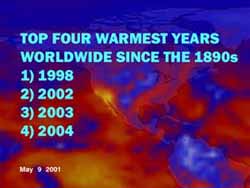NASA finds 2004 fourth warmest in over a century

2004- The Fourth Warmest Year in a Century: 2004 was the fourth warmest year around the world, since the late 1800s, according to NASA scientists. 1998, 2002 and 2003 were the only years warmer since the 1890s. This image is from the Clouds and the Earth’s Radiant Energy System (CERES), an instrument on 3 NASA satellites. It shows energy reflected back to space. The levels of reflected energy increase from blue to red to yellow. The yellow area shows a heatwave over California in May 2001. Credit: NASA GSFC/LARC and SVS
Last year was the fourth warmest year on average for our planet since the late 1800s, according to NASA scientists.
To determine if the Earth is warming or cooling, scientists look at average temperatures. To get an “average” temperature, scientists take the warmest and the coolest temperatures in a day, and calculate the temperature that is exactly in the middle of those high and low values. This provides an average temperature for a day. These average temperatures are then calculated for spots all over the Earth, over an entire year.
Scientists use temperatures taken on land and on surfaces of the oceans. Weather stations provide land measurements, and satellites provide sea surface temperature measurements over the ocean. These data are computed by NASA. The end result recreates and calculates global temperatures, and helps scientists study climate change. Makiko Sato of NASA’s Goddard Institute for Space Studies (GISS), New York, converted all the data into readable global temperature maps that provided the means to see the warming.
James Hansen of NASA GISS analyzed the data and said that the 2004 average temperature at Earth’s surface around the world was 0.48 degrees Celsius or 0.86 Fahrenheit above the average temperature from1951 to 1980.
Globally, 1998 has proven to be the warmest year on record, with 2002 and 2003 coming in second and third, respectively. “There has been a strong warming trend over the past 30 years, a trend that has been shown to be due primarily to increasing greenhouse gases in the atmosphere,” Hansen said.
Global temperatures vary from year to year and place to place, but weather stations and satellite data provide accurate records. By recording them over time, scientists develop a record of the climate, and have been able to see how it’s been changing.
Some of the changes in climate are due to short-term factors like large volcanic eruptions that launched tiny particles of sulfuric acid into the upper atmosphere (stratosphere) in 1963, 1982, and 1991. These natural events can change climate for periods of time ranging from months to a few years. Other natural events, like El Ninos, when warm water spreads over much of the tropical Pacific Ocean, also have large short-term influences on climate. The large spike in global temperature in 1998 was associated with one of the strongest El Ninos of recent centuries, and a weak El Nino contributed to the unusually high 2002-2003 global temperatures.
Even though big climate events like El Nino affect global temperatures, the increasing role of human-made pollutants plays a big part. Scientists, like Hansen, have been working to try and predict how human impacts on our climate will affect the annual world temperature trends in the future.
Hansen also said that now, Earth’s surface absorbs more of the Sun’s energy than gets reflected back to space. That extra energy, together with the weak El Nino, is expected to make 2005 warmer than the years of 2003 and 2004 and perhaps even warmer than 1998, which had stood out as far hotter than any year in the preceding century.
Another interesting note is that global warming is now large enough that it is beginning to affect seasons, and make them warmer than before on a more consistent basis.
Compared to the average temperatures from the 1951 to 1980 period, the largest unusually warm areas over all of 2004 were in Alaska, near the Caspian Sea, and over the Antarctic Peninsula. But compared to the previous five years, the United States as a whole was quite cool, particularly during the summer.
For the original article by Drs. James Hansen and Makiko Sato, please visit on the Internet: http://www.giss.nasa.gov/data/update/gistemp/2004/
Media Contact
All latest news from the category: Earth Sciences
Earth Sciences (also referred to as Geosciences), which deals with basic issues surrounding our planet, plays a vital role in the area of energy and raw materials supply.
Earth Sciences comprises subjects such as geology, geography, geological informatics, paleontology, mineralogy, petrography, crystallography, geophysics, geodesy, glaciology, cartography, photogrammetry, meteorology and seismology, early-warning systems, earthquake research and polar research.
Newest articles

Bringing bio-inspired robots to life
Nebraska researcher Eric Markvicka gets NSF CAREER Award to pursue manufacture of novel materials for soft robotics and stretchable electronics. Engineers are increasingly eager to develop robots that mimic the…

Bella moths use poison to attract mates
Scientists are closer to finding out how. Pyrrolizidine alkaloids are as bitter and toxic as they are hard to pronounce. They’re produced by several different types of plants and are…

AI tool creates ‘synthetic’ images of cells
…for enhanced microscopy analysis. Observing individual cells through microscopes can reveal a range of important cell biological phenomena that frequently play a role in human diseases, but the process of…





















